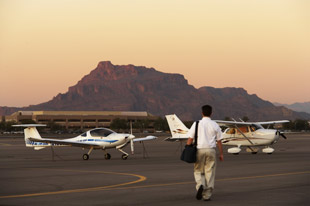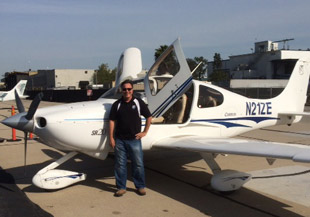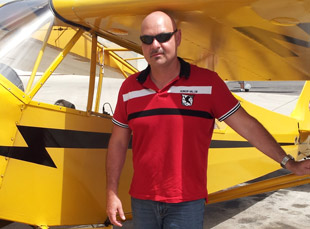New York tax exemption saves aircraft owners thousands

Illustration by John Holm
New Yorkers who are considering buying an aircraft that will be based in the state can save at least 4 percent starting September 1. The sales and use tax exemption applies to all general aviation aircraft, whether Experimental, Light Sport, or certificated; piston or jet. There are no size or capacity restrictions.
Michael Giardino, president of the New York Aviation Management Association, said the tax exemption “levels the playing field” with nearby states that have similar exemptions and removes the temptation for New Yorkers to base their aircraft outside the state. “You can bring your aircraft home,” Giardino said. The state aviation association has been focused on this initiative for nearly a decade.
What kind of savings does this exemption mean for aircraft owners? A pilot in the market for a $50,000 used aircraft, such as a Cessna 172 or Van’s Aircraft RV–6, would save at least $2,000 on upfront purchase costs. Considering the average cost of avgas at New York FBOs is $5.80 per gallon, the pilot could use that savings to buy enough avgas for 34 hours of flight time (based only on fuel costs and a conservative fuel burn of 10 gph). Someone buying a 2015 Cirrus SR22 GTS for about $700,000 would save at least $28,000.
“AOPA works hard with state aviation industries to reduce barriers to entry and lower the cost of aircraft ownership,” said Sean Collins, AOPA Eastern Regional manager. “Because the state retains the 2004 tax exemption on aircraft maintenance, this new sales and use tax exemption makes ownership a lot easier.”
AOPA and the New York Aviation Management Association estimate that since 2002, the state lost nearly 700 based aircraft, causing New York’s airports to struggle as a result of the competitive disadvantage.
SURVEY: 58% of AOPA members are instrument-rated pilots.
Action In the States
State by state
Alaska Region
The Great Alaska Aviation Gathering kicked off the summer flying season in Alaska, with an AOPA Rusty Pilot seminar and speakers from AOPA.
Western Pacific Region
Arizona’s state Senate has passed an AOPA-supported bill that would alleviate taxes on aviation businesses that already pay federal fees, sending the measure back to the House for a final vote. California-based AOPA Ambassador Kay Sundaram is working with numerous flight schools and flying clubs in the San Diego and Los Angeles areas. Sundaram is sharing AOPA resources with the groups and helping them host Rusty Pilot programs to get lapsed pilots back in the air. A bill that would have banned aerial banner towing in Hawaii has died in the House after facing serious opposition from the aviation community.
Northwest Mountain Region
In Colorado, AOPA Regional Manager David Ulane met with the Airport Support Network volunteer, the Airport Advisory Board, and the new airport manager at Longmont/Vance Brand Airport to discuss opportunities to improve the busy field’s relationship with its neighbors. Ulane is slated to take part in both the Idaho Airport Management Association’s annual conference in Coeur d’Alene and the Idaho Aviation Association’s annual convention in Idaho Falls in May. Meanwhile in Oregon, AOPA is contesting a siting permit for the Troutdale Energy Center adjacent to Portland-Troutdale Airport because of concerns about severe turbulence that could be caused by the power plant. AOPA presented evidence of the possible impacts in written testimony in the case. In Utah, Gov. Gary Herbert proclaimed April “Aviation Appreciation Month,” specifically recognizing the efforts of AOPA and other associations in promoting GA in the state. In Washington, Ulane briefed legislators on the status of the Pilot’s Bill of Rights 2 and the FAA’s Piston Aviation Fuels Initiative.
Central Southwest Region
Arkansas Gov. Asa Hutchinson has signed legislation that will exempt non-Arkansas residents from paying the state’s gross receipts tax and compensating use tax when buying an aircraft from another non-Arkansas resident. The bill would also exempt turbine aircraft weighing 12,500 or more pounds from paying sales and use tax on aircraft parts and labor. Louisiana Gov. Bobby Jindal and the mayors of four Louisiana cities, including Baton Rouge, Hammond, New Iberia, and Ruston, all proclaimed March 2015 Aviation Appreciation Month. AOPA took part in Missouri State Aviation Day in Jefferson City, where Regional Manager Yasmina Platt discussed issues including the recreational use statute and creating a fly-away exemption. The New Mexico state legislature adjourned for the year without acting on various bills that would have raised the cost of flying in New Mexico. Platt had told lawmakers that proposals to increase taxes on aviation fuels and divert the new money to other parts of the state budget would jeopardize FAA funding, which is predicated in part on assurances that monies raised from taxes on aviation fuel will be spent on aviation infrastructure. Platt noted that forgoing those FAA funds would in turn jeopardize jobs and limit the state’s ability to pay for upkeep and improvements to airports. Another bill that would have taken 20 percent of the unspent money from the state aviation fund at the end of each fiscal year and transferred it to the state general fund would likewise have jeopardized FAA funding. That bill also was left on the table as the session ended, effectively defeating it. AOPA is working with the Oklahoma Aeronautics Commission to support H.B.1549, which would prevent additional wind turbines from being built too close to airports. According to a 2013 study by the University of Kansas, the turbines on a wind farm can set up a circular vortex as far away as 3 miles, which can catch a small airplane and spin it around if it gets too close. Platt was in the Texas Capitol to testify in favor of H.B.1458, legislation that would exempt GA maintenance from state sales taxes. A similar exemption is already available to air carriers, flight training aircraft, and agricultural aircraft.
Great Lakes Region
AOPA has been meeting with lawmakers to urge passage of Illinois S.B.1280 to reduce GA fuel taxes and increase state funding for airport improvements. In Indiana, AOPA is helping businesses that want to expand their use of GA by providing a regional economic snapshot of GA and its contributions to the state. AOPA submitted testimony in favor of Michigan H.B.4244, which provides liability protection for private airfield owners. The measure has been approved by the House Judiciary Committee. AOPA Regional Manager Bryan Budds met with Minnesota Aeronautics Director Cassandra Isackson to discuss the future of unleaded aviation fuel and efforts to grow the pilot population. In North Dakota, AOPA is working to prevent increases in registration fees for GA aircraft and has held meetings with members of the North Dakota House Transportation Committee to ensure GA aircraft aren’t unfairly targeted. Budds traveled to Columbus to advocate for Ohio H.B.32, which would lower the state aviation fuel tax rate and increase airport funding. Budds met with members of the South Dakota Aeronautics Commission to update them on third class medical reform and other member priorities. AOPA is working with the Department of Transportation Bureau of Aeronautics to explore opportunities to strengthen GA in Wisconsin.
Eastern Region
Regional Manager Sean Collins is continuing conversations with Connecticut Gov. Dannel Malloy’s office and the state’s airport authority on ideas for boosting activity at Connecticut’s GA airports. Collins is at work in Delaware, where he met with Gov. Jack Markell’s office and the state aeronautics division on creating a dedicated aviation trust fund to benefit Delaware’s airports. Collins is continuing to help the Maine Aviation Business Association develop materials to help build support for GA in the state. AOPA presented an update on GA issues at the Massachusetts Airport Managers Association quarterly meeting and took part in the Maryland Aviation Management Association’s monthly meeting. In New Hampshire, Collins took part in the New England Aviation Safety Expo, where he networked with the local aviation community and shared information about AOPA’s efforts nationally and in the state. AOPA is working with the New Jersey Aviation Association to help sponsor an aviation conference in the state. After more than a decade of AOPA advocacy efforts, the New York legislature has passed a state budget that includes a sales and use tax exemption on aircraft purchased in the state. That bill has now been signed into law, marking a major victory for businesses and individuals who want to buy aircraft in the state (see “Bring Your Airplane Home,” page 96). In Pennsylvania, Collins is working with the Department of Economic and Community Development to come up with a plan for improving the state’s competitiveness and lowering the cost of flying. Collins has discussed ways to boost GA in Vermont with the leaders of the state aeronautics division.
Southern Region
Florida Gov. Rick Scott reiterated his state’s appreciation of the $144 billion in economic activity associated with aviation, noting that 8.5 percent of the state’s total economic output comes from businesses that depend on aviation. Kentucky will look at the role GA plays in the state. Gov. Steve Beshear has signed AOPA-backed legislation to launch a new study on the impact of aviation. Business owners and pilots at Michael J. Smith Field in Beaufort, North Carolina, say airport improvements are beginning to pay dividends. Since Runway 8/26 was lengthened to 5,000 feet, jets have been able to land even in bad weather, airport businesses have reported increased activity, and other community businesses say they’ve benefited from the arrival of customers who wanted easy jet access to the community. AOPA member, airshow performer, and formation pilot J. Reid Garrison was recently inducted into the South Carolina Aviation Hall of Fame. Garrison may be best known for performing aerobatics in a de Havilland DHC–1 Chipmunk. He’s also an award-winning aircraft restorer, who has proudly revitalized Beechcraft T–34 Mentors, a North American T–28, two North American T–6Gs, and 12 Chipmunks.
Washington, D.C.: After a gyroplane flew into the Washington, D.C., Flight Restricted Zone and landed on the Capitol lawn, AOPA quickly stated that the operator’s actions were “unacceptable” and that they “should in no way be associated with the law-abiding professional and recreational pilots who every day follow the rules and regulations of the National Airspace System.”
Town’s new noise rules
‘Unacceptable,’ AOPA says
 East Hampton, New York, is expected to begin enforcing new rules against aircraft deemed noisy—primarily helicopters and business jets—this summer. Town officials said enforcement will begin on Memorial Day weekend.
East Hampton, New York, is expected to begin enforcing new rules against aircraft deemed noisy—primarily helicopters and business jets—this summer. Town officials said enforcement will begin on Memorial Day weekend.
A group of associations, operators, and other airport backers filed suit in January in an effort to force the FAA to override the town’s new rules. The legal action specifically challenges the FAA decision to waive its authority to preclude local limits on aircraft operations. A spokesman for Friends of East Hampton Airport said the restrictions are severe, and illegal.
East Hampton officials opted not to pursue the most restrictive measure that had been considered—a weekend ban on all helicopters during the summer tourist season—but went ahead with other measures, including a yearlong, mandatory curfew from 11 p.m. to 7 a.m. daily. The town board also approved an extended daily curfew for aircraft deemed noisy (with a list of such aircraft to be compiled based on published noise characteristics that will include various helicopter and business jet models) from 8 p.m. to 9 a.m., and limited the operations of noisy aircraft to one takeoff and landing per calendar week from May 1 to September 30. Town officials estimate the restrictions will eliminate thousands of operations per year, most of them helicopter operations.
AOPA staff is working with operators and members in the area, and other aviation groups involved. Various options are being considered.
FAA releases list of instrument approaches to be eliminated
The FAA has published a list of 736 redundant or underutilized VOR and NDB standard instrument approach procedures that the agency proposes to eliminate as it moves forward with implementation of the NextGen satellite-based air traffic system.
The long-awaited list, published in the Federal Register in a notice of proposed rulemaking, was based on criteria established in 2014 by the VOR Minimum Operational Networking Group, in which AOPA participated, said Melissa Rudinger, AOPA vice president of government affairs. “The goal of the working group is to ensure that a scaled-back VOR system is maintained well into the future, even as the system and operators move to satellite-based navigation.
The FAA said “complexity and cost ruled out maintaining all existing approach infrastructure during the transition to new technology.” The agency originally set a target of reducing the number of VORs from approximately 967 operating in late 2012 to 500 in service by January 1, 2020, the target date for full implementation of NextGen. However, based on industry feedback and coverage requirements, the FAA has revised that target to 867 VORs in service by January 1, 2020, and 667 by 2025. Members may review the approaches selected for elimination in the Federal Register notice or the FAA website.
Products and Services
Hand propping
A legal primer
By Mike Yodice
There is no specific FAA regulation that applies to hand propping an airplane, either to prohibit it or direct how it is to be done. It’s an action that can be accomplished safely. For many of us who operate airplanes without starters, it is commonplace and, of course, necessary in order to go flying.
The FAA contends that hand propping is a two-person operation and has expressed this view in the Airplane Flying Handbook (FAA-H-8083-3A) under the section titled “Hand propping.” This publication is not regulatory, but the NTSB was surely influenced by it in a 1983 legal decision. In that case, the FAA sought to suspend a pilot’s certificate for being careless or reckless when, while attempting to start a Vari-Eze Experimental aircraft, it “got away” and ran into a parked aircraft. At the initial hearing, the NTSB administrative law judge ruled in favor of the FAA and ordered a 40-day suspension of the pilot’s certificate. The pilot appealed the judge’s decision to the full board.
The pilot testified that he was having trouble starting the engine because it was flooded. He sought the assistance of a nonpilot companion, who was instructed to reach inside the cockpit and pull the throttle back when the engine started (yes, the throttle was in the full open position). Well, the engine started, the companion failed to close the throttle, and the airplane indeed “got away.” The NTSB affirmed the administrative law judge’s finding that there had been a 91.10 (now 91.13) violation. The board maintained that, “The standard procedures set forth in the Federal Aviation Administration’s Flight Training Handbook provide that an engine should never be hand-propped unless a qualified individual is seated at the controls and the brake is set. In addition, the Handbook urges that chocks be placed in front of the main wheels and that if this is not possible, the airplane’s tail should be securely tied down.”
There have been at least two previously issued NTSB decisions and one subsequent decision that refer to these generally accepted procedures and precautions for hand propping. The precedent has been set. So, hand proppers beware; if you fail to follow proper precautions and the airplane gets away, the FAA might pursue action against you for being careless or reckless.
Mike Yodice counsels Legal Services Plan/Pilot Protection Services members on such issues as FAA compliance and enforcement.
Insurance services
AOPA offers options on term life
Life insurance can sometimes seem like an afterthought. With so many policies that pay out only after your death, AOPA offers an accelerated life benefit with any term life policy. This is where the “Living Benefits” of your plan kick in. If you are diagnosed with a terminal illness with less than six months to live, you can request up to 50 percent of your benefits through your plan’s accelerated life benefit. Once you have received your benefit you can spend it however you please. It could go towards medical expenses, home expenses, or anything of your choosing. Your remaining benefits will then be paid to your beneficiary(ies) after your death. AOPA wants to help you and your family be prepared no matter what happens, so you don’t have to worry about their security and can enjoy your final days with them. Learn more about this and other products brought to you by AOPA Insurance Services online or by calling 877-432-2672 to speak with a representative.
On the web: To learn more about AOPA Pilot Protection Services, visit the website.

Are you ready to go on vacation?
Not much can trump the fun of flying GA to our holiday destination: We get to do something we enjoy and avoid standing barefoot in long TSA lines or being held up in traffic on that eight-hour drive to the beach. But let’s plan to stay out of the sometimes grim headlines that follow holiday weekends by reciting the Air Safety Institute’s Vacation Pilot Safety Announcement, a “ghastly” rhyme and darkly humorous reminder of the various ills that can befall the careless or unwary vacation flier. Make sure your name isn’t next on the list.
AOPA Foundation
Donations to the AOPA Foundation help fund the safety education products the Air Safety Institute is known for. Consider a donation today and help keep these free resources available for pilots everywhere.
Air Safety Institute
‘Transitioning to Other Airplanes’ interactive course now online
Ease the jump into unfamiliar airplanes or avionics
 It’s great fun to explore the flight envelope of a different airplane that offers new and exciting experiences and stretches our horizon—and done right, the experience will help make us safer and more capable pilots. The first step to doing it right is to recognize that whether you’re an experienced ATP or a freshly minted sport pilot, when flying equipment that is different from what you’re accustomed to, it’s important to get a thorough understanding of the new handling characteristics, systems, operating environments, avionics, cockpit layout, and other variations to ensure your safety and that of your passengers.
It’s great fun to explore the flight envelope of a different airplane that offers new and exciting experiences and stretches our horizon—and done right, the experience will help make us safer and more capable pilots. The first step to doing it right is to recognize that whether you’re an experienced ATP or a freshly minted sport pilot, when flying equipment that is different from what you’re accustomed to, it’s important to get a thorough understanding of the new handling characteristics, systems, operating environments, avionics, cockpit layout, and other variations to ensure your safety and that of your passengers.
When you’re ready to make the move, know that the AOPA Air Safety Institute has your back to help make that switch safe and fun: Its first-of-a-kind Transitioning to Other Airplanes online course offers straightforward, important insights on what to expect before, during, and after the transition and how to remedy unsafe situations—whether shifting from a Boeing 747 to a Piper J–3 Cub or a 1971 Bonanza to a 2013 model. The course offers five study tracks for transitions not requiring an FAA checkride: transitioning up, down, sideways, to Experimental amateur-built aircraft, and to new avionics. Only one track is required to earn a completion certificate, but you can take as many tracks as you like.
Be prepared to tackle transitioning hiccups and cope with exciting, but sometimes challenging, encounters—and enjoy your new adventure! Take the free course on your desktop or mobile device.
California pilot first ‘Learn & Earn Safety Challenge’ winner
 Michael Campolo is excited about having returned to flying after a 20-year hiatus. In a surprise phone call from AOPA Air Safety Institute Senior Vice President George Perry, Campolo learned he had won a Stratus 2 Automatic Dependent Surveillance-Broadcast (ADS-B) receiver, courtesy of Sporty’s Pilot Shop, for actively participating in the Air Safety Institute’s “Learn & Earn Safety Challenge.” Campolo has been busy brushing up on his skills with the institute’s award-winning courses, videos, and case studies.
Michael Campolo is excited about having returned to flying after a 20-year hiatus. In a surprise phone call from AOPA Air Safety Institute Senior Vice President George Perry, Campolo learned he had won a Stratus 2 Automatic Dependent Surveillance-Broadcast (ADS-B) receiver, courtesy of Sporty’s Pilot Shop, for actively participating in the Air Safety Institute’s “Learn & Earn Safety Challenge.” Campolo has been busy brushing up on his skills with the institute’s award-winning courses, videos, and case studies.
“The programs are structured so you can focus on the subject matter and complete them in a timely manner,” said Campolo. He’s pleased that AOPA and other industry resources are helping lapsed pilots back into the air with initiatives such as AOPA’s Rusty Pilots Program. “Winning Sporty’s Stratus 2 ADS-B receiver was a great surprise—it will be a perfect companion in the cockpit,” he said.
Enter the Air Safety Institute’s “Learn and Earn Safety Challenge” for a chance to win each time you complete a free online safety course, Real Pilot Story, or Accident Case Study. Visit the website for complete rules and additional details.
Aviation Finance
‘Thanks, AOPA!’
AOPA Aviation Finance found a lender ‘that understood me’
 When he was 16 years old, Jorge Gonzalez and his father were in their car when they passed by Lewis University Airport (LOT) southwest of Chicago. “We decided to stop in and inquire about flying lessons. An instructor took me up in a Cessna 152 and that’s all it took, I was hooked,” Gonzalez said.
When he was 16 years old, Jorge Gonzalez and his father were in their car when they passed by Lewis University Airport (LOT) southwest of Chicago. “We decided to stop in and inquire about flying lessons. An instructor took me up in a Cessna 152 and that’s all it took, I was hooked,” Gonzalez said.
He is currently a 600-hour private pilot with instrument and rotorcraft ratings, working on his commercial certificate. “Now at 40 with three kids, I decided to buy a little something we can afford to introduce my kids to the wonderful world of flight.” But, he says, “life gets in the way sometimes,” and he has a challenging credit history.
His first stop was to his local bank, where he’d been a customer for 20 years. “I requested a loan, but was swiftly denied.” His credit has been good for six years, and he says he has been current on all his obligations.
Next, he contacted AOPA Aviation Finance and immediately got a return response from a loan specialist. “I explained my situation and he diligently and successfully found a lender that understood me. Within a week I was funded and bought a little Experimental LSA Rans Airaile. Thanks, AOPA, for all the wonderful things you do.”
If you, like Jorge Gonzalez, have special circumstances when it comes to securing a loan, contact AOPA Aviation Finance at 800-62-PLANE or go online (aopafinance.com). AAF’s friendly staff will speak your language and take the confusion out of buying an airplane. Don’t forget that using AAF not only helps you, but also helps AOPA in its mission to keep GA airports open and support your right to fly.
Answers for pilots
Drink up
Kidney stones. If you’ve ever had one, you know the pain can be sudden, intense, and incapacitating. While there’s no guaranteed way to prevent kidney stones, staying well hydrated can help minimize their likelihood. Summer is a particular challenge. As temperatures and humidity climb and you become more active outdoors, it’s important to increase the amount of water you drink. Kidney stones are fairly common, and a history of a single stone can have little impact on your next medical, but a second or subsequent stone requires a special issuance medical certificate. Read more in this month’s Answers for Pilots. Call the aviation medical specialists in AOPA’s Pilot Information Center, Monday through Friday, 8:30 a.m. to 6 p.m. Eastern Time, 800-USA-AOPA (872-2672).


